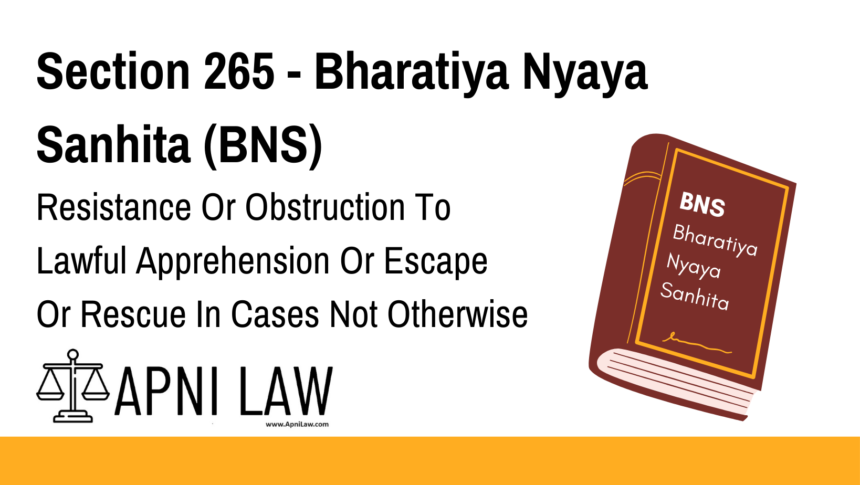Code: Section 265 BNS
Whoever, in any case not provided for in section 262 or section 263 or in any
other law for the time being in force, intentionally offers any resistance or illegal obstruction
to the lawful apprehension of himself or of any other person, or escapes or attempts to
escape from any custody in which he is lawfully detained, or rescues or attempts to rescue
any other person from any custody in which that person is lawfully detained, shall be
punished with imprisonment of either description for a term which may extend to six months,
or with fine, or with both.
Explanation of Section 265 BNS
Section 265 of the Bharatiya Nyaya Sanhita (BNS) addresses situations where a person illegally resists, obstructs, or attempts to escape from lawful custody, or rescues someone who is lawfully detained. This section applies to cases that are not specifically covered under sections 262 or 263 or any other law in force.
It aims to maintain the integrity of legal procedures and ensure that lawful apprehension and custody are not obstructed.
Key Elements of the Offense
- Intentional Resistance or Obstruction:
- The act must be intentional, meaning the person deliberately resists or obstructs lawful apprehension.
- Lawful Apprehension or Custody:
- The person must be under lawful custody or subject to lawful apprehension.
- Cases Not Covered by Sections 262 or 263:
- This section applies where no other specific law governs the offense.
- Forms of Offense:
- Resistance to apprehension (of oneself or another person).
- Escape from lawful custody or attempting to do so.
- Rescue of a person from lawful custody or attempting to do so.
Illustrations
Example 1: Resistance to Lawful Apprehension
A person is wanted by the police for a crime. When the police come to arrest him, he physically resists and fights the officers. This act of resistance is punishable under Section 265.
Example 2: Attempt to Escape from Custody
A prisoner attempts to escape from prison by climbing over the wall. Since it’s a case not covered under Section 262 or 263, this act falls under Section 265.
Example 3: Rescuing a Lawfully Detained Person
A person illegally frees someone from police custody, knowing that the individual is lawfully detained for a crime. This act of rescue is punishable under this section.
Common Questions and Answers on Section 265 BNS
1. What kind of resistance is punishable under Section 265?
- Answer: Any intentional resistance or illegal obstruction to lawful apprehension of oneself or another person.
2. Does this section apply to cases where the person is not under arrest?
- Answer: Yes, if the person is lawfully detained or subject to lawful apprehension, the section applies.
3. What is the punishment under this section?
- Answer: Imprisonment for up to 6 months, or a fine, or both.
4. Does the section apply if the person escapes from a temporary custody?
- Answer: Yes, as long as the custody is lawful, the section applies, even if the custody is temporary.
5. How is Section 265 different from Sections 262 and 263?
- Answer: Sections 262 and 263 deal with specific offenses related to resistance or obstruction when the person is already under lawful arrest or custody. Section 265 applies to cases not covered under those sections.
Conclusion
Section 265 of the Bharatiya Nyaya Sanhita (BNS) ensures the smooth functioning of law enforcement by addressing cases of resistance, obstruction, escape, and rescue in situations not covered by other laws. It acts as a general provision to maintain public order, protect law enforcement officers, and ensure that justice is not obstructed.








